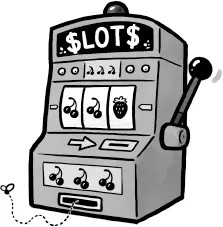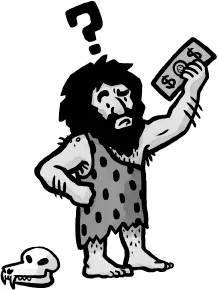1
DON’T BET ON IT
George Jones* needs to blow off some steam. Work is stressful, the kids are fighting, and money is tight. So on a company trip to Las Vegas he heads to a casino. He parks, for free, in the lot at the end of a remarkably well-kept, publicly financed road and wanders aimlessly, head down, into the alternate universe of the casino.
The sound wakes him from his stupor: eighties music and cash registers mixed with clinking coins and the dinging of a thousand slot machines. He wonders how long he’s been at the casino. There are no clocks, but judging by the old people slumped at the slot machines, it might have been a lifetime. It was probably five minutes. He couldn’t be far from the entrance. But, then again, he can’t see the entrance . . . or the exit . . . or any doors or windows or hallways or means of escape whatsoever. Just flashing lights, scantily clad cocktail servers, dollar signs, and people who are either ecstatic or miserable . . . but never anything in between.
Slot machines? Sure, why not? His first spin just misses a big score. So he spends fifteen minutes pumping in dollar bills to catch up. He never wins, but he does just miss quite a few more times.
Once his wallet is emptied of those pesky small-denomination bills, George grabs two hundred bucks at the ATM—not worrying about the $3.50 service fee because he’ll cover that with his first winning hand—and sits down at a blackjack table. In exchange for ten crisp $20 bills, the dealer gives him a colorful pile of red plastic chips. There’s a picture of the casino on them, with some feathers and an arrow and a teepee. They say $5, but they certainly don’t feel like money. They feel like toys. George twirls them in his fingers, bounces them off the table, watches everyone’s piles fluctuate, and covets the dealer’s rainbow stash. George asks her to be kind to him. “Honey, as far as I’m concerned, you can have all of it—it ain’t mine.”
A cute, friendly server brings George a free drink. Free! What a deal! He’s already winning. He tips her one little plastic toy chip.
George plays. George has some fun. George has some of the opposite of fun. He wins a little, loses more. Sometimes, when the odds seem to be in his favor, he doubles down or splits his cards, risking four chips instead of two, six instead of three. He ends up losing his $200. Somehow he avoids duplicating his tablemates’ feats of amassing giant stacks of chips one minute, then unfurling reams of bills to buy more the next. Some of them are good-natured, some get angry when others “take their card,” but none seem like the type who can afford to lose $500 or $1,000 in an hour. Still, this happens time and time again.
Earlier that morning, George had turned around just ten steps from his local café because he could save $4 by brewing coffee back at his hotel room. This evening, he tossed away forty $5 chips without blinking. Heck, he even gave the dealer one for being so nice.
WHAT’S GOING ON HERE?
Casinos have perfected the art of separating us from our money, so it’s a little unfair of us to start here. Nonetheless, George’s experience gives us a quick glimpse into some of the psychological mistakes we make, even in less malicious settings.
The following are a few of the factors at play under the dazzling lights of the casino floor. We’ll get into each of these in much more detail in the chapters to come:
Mental Accounting. George is worried about his finances—as evidenced by his decision to save money on coffee in the morning—yet nonchalantly spends $200 at the casino. This contradiction occurs, in part, because he puts that casino spending into a different “mental account” than the coffee. By taking his money and converting it into pieces of plastic, he opens an “entertainment” fund, while his other spending still comes out of something like “daily expenses.” This trick helps him to feel differently about the two types of spending, but they’re all really part of one account: “George’s money.”
The Price of Free. George is excited to get free parking and free drinks. Sure, he’s not paying for them directly, but these “free” things get George to the casino in a good mood and impair his judgment. These “free” items, in fact, extract a high cost. There is a saying that the best things in life are free. Maybe. But free often ends up costing us in unexpected ways.
The Pain of Paying. George doesn’t feel like he’s spending money when he uses the colorful casino chips to gamble or tip. He feels like he’s playing a game. Without feeling the loss of money with every chip, without being fully aware that he’s spending it, he becomes less conscious of his choices and less considerate of the implications of his decisions. Spending plastic doesn’t feel real the way that handing over paper bills would, so he keeps tossing them away.
Relativity. That $5 tip George gave the server—on a free drink—and his $3.50 ATM fee don’t seem consequential compared to the stacks of chips surrounding him at the blackjack table or the $200 he was simultaneously taking out at the ATM. Those are relatively small amounts of money, and because he is thinking about them in relative terms, it is easier for him to go ahead and spend. Earlier in the day, on the other hand, the $4 coffee, compared to the $0 coffee at his hotel room, felt relatively too much to spend.
Expectations. Surrounded by the sights and sounds of money—cash registers, bright lights, dollar signs—George fancies himself a James Bond, 007, inevitable, suave victor over long casino odds and supervillains alike.
Self-Control. Gambling, of course, is a serious issue—an addiction, even—for many people. For our purposes, however, we can simply say that George, influenced by his stress and surroundings, the friendly staff, and “easy” opportunities, has a hard time resisting the immediate temptations of gambling for the distant benefits of having $200 more when he retires.
All of these mistakes may seem like they’re unique to a casino, but in truth, the whole world is a lot more like a casino than we’d like to admit: In 2016, America even elected a casino owner as president, after all. Although we don’t all blow off steam by gambling, we do all face similar decision-making challenges in terms of mental accounting, free, the pain of paying, relativity, self-control, and more. The mistakes George makes in the casino happen in many aspects of our daily lives. These mistakes are fundamentally rooted in our basic misunderstanding of the nature of money.
Although most of us probably believe we have a decent grasp of money as a topic, the surprising truth is, we really don’t understand what it is and what it does for us, and, more surprisingly, what it does to us.
2
OPPORTUNITY KNOCKS
So, what exactly is money? What does it do for us and to us?
Those thoughts surely never crossed George’s mind at the casino, and rarely, if ever, do they cross our minds. But they are important questions to ask and a great place to start.
Money represents VALUE. Money itself has no value. It only represents the value of other things that we can get with it. It’s a messenger of worth.
That’s great! Money makes it easy to value goods and services, which makes it easy to exchange them. Unlike our ancestors, we don’t have to spend a lot of time bartering, plundering, or pillaging to get basic necessities. That’s good, because few of us are handy with a crossbow or a catapult.
There are certain special features of money that make it extra useful:
It is
general: We can exchange it with almost everything
It is
divisible: It can be applied to almost any item of any size, no matter how large or small.
It is
fungible: We don’t need a specific piece of currency, because it can be replaced by any other piece representing the same amount. Any $10 bill is as good as any other $10 bill, no matter where and how we get it.
It is
storable: It can be used at any time, now or in the future. Money doesn’t age or rot, unlike cars, furniture, organic produce, or college T-shirts.
In other words, any amount of any money can be used at any time to buy (almost) anything. This essential fact helped us humans—Homo irrationalis—to stop bartering with each other directly and, instead, use a symbol—money—to exchange goods and services with much greater efficiency. That, in turn, gives money its final and most important feature: It is a COMMON GOOD, which means it can be used by anyone and for (almost) anything.
When we consider all of these characteristics, it is easy to see that there would be no modern life as we know it without money. Money allows us to save, to try new things, to share, and to specialize—to become teachers and artists, lawyers and farmers. Money frees us to use our time and effort to pursue all kinds of activities, to explore our talents and passions, to learn new things, and to enjoy art and wine and music, which themselves would not exist to any great extent without money.
Money has changed the human condition as much as any other advance—as much as the printing press, the wheel, electricity, or even reality television.
While it is important to recognize how important and use...






